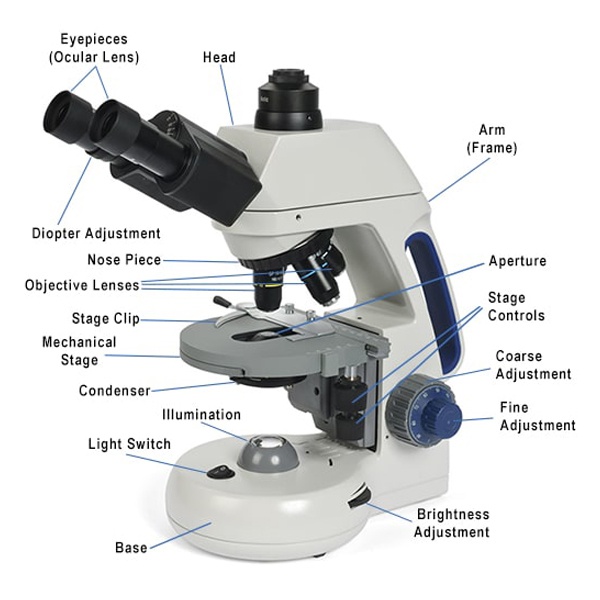What is a Compound Microscope?
A compound microscope is an instrument that is used to view magnified images of small specimens on a glass slide. It can achieve higher levels of magnification than stereo or other low power microscopes and reduce chromatic aberration. It achieves this through the use of two or more lenses in the objective and the eyepiece. The objective lens or objectives located on the nosepiece have a short focal length and are close to the target specimen where it collects light and focuses the image of the object into the microscope. The second lens, in the eyepiece, has a longer focal length and further enlarges the image.
The Characteristics of a Compound Microscope
- Two or more convex lenses
- Typical magnification range between 40x and 1000x
- One objective is used at a time
- Two-dimensional images
- Available in monocular, binocular, trinocular, and multi-head configurations

What is a Compound Microscope Used For?
Most of us remember using a microscope at some point in school, usually in biology class (or a science class that included a section on biology), and for most of us it was the same kind of microscope. A biological microscope is one kind of a compound microscope. Sometimes other names are used for biological microscopes too. If you hear either of the terms "brightfield microscope" or "transmitted light microscope," it is referring to the same thing.
There are other types of compound microscopes in common use too. A phase contrast microscope uses a special lens, called a "phase contrast objective lens," together with a phase slider (or phase turret condenser). This combination intensifies the contrast of the object being observed, without the need to stain it with dye. These "phase contrast" microscopes are often used in university and medical research settings, to look at bacteria, blood cells, and other tiny structures in living creatures. We’ll go into them in more detail below.
Another type of compound microscope is the polarizing microscope. These use an analyzer and a polarizer to cross-polarize and pick out even subtle differences in colors in the optical path of whatever it is being examined. These microscopes are especially useful in science and industries that examine chemicals. Pharmaceutical companies, petrologists and geologists often use polarizing microscopes for the examination of chemicals, minerals, and thin slices of rock sample.
A metallurgical microscope is another of the compound microscopes and, as the name indicates, is often used in metallurgy and related endeavors. These microscopes may have transmitted and reflected light working together, or only reflected light. The reflected light enters through the objective lens. These microscopes are most useful when it comes to viewing materials that are opaque, that don’t allow any light to pass through them. Another technique used to observe opaque substances using metallurgical microscopes is called "darkfield microscopy." This technique backlights the observed object to help highlight specific features of the metal, including flaws in precious stones or hairline cracks in metals.
Finally, fluorescence microscopes and differential interference contrast microscopes (DICs) are other types of compound microscope. They are both used most commonly in biology-related fields and use different light wavelengths to fluoresce an object under observation, highlighting particular features of the sample.
How Compound Microscopes Function
Light starts its journey at the base of the microscope from the source of illumination. This light travels upwards through the condenser and aperture where it then passes through the contents of the stage. The image of the slide or specimen on the stage is picked up by the powerful magnification of the objective lens above it (4x, 10x, or 100x). The light then moves up the head of the microscope where it reaches the eyepiece and is again magnified by the ocular lenses (5x-30x, 10x eyepiece is by far the most common).
Learn more about each compound microscope part and functions here.
You can learn about other types of microscopes on our other informative pages below:
- What is a stereo microscope?
- What is a digital microscope?
- What is a fluorescence microscope?
- How to use a microscope
